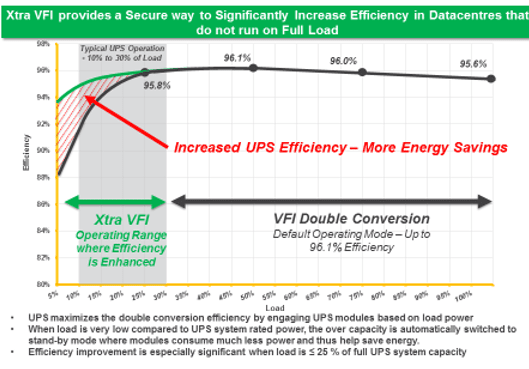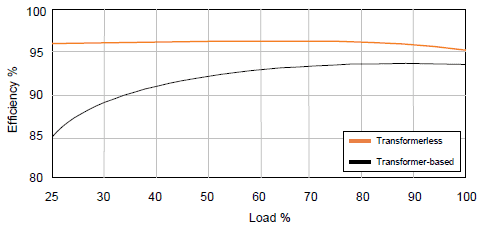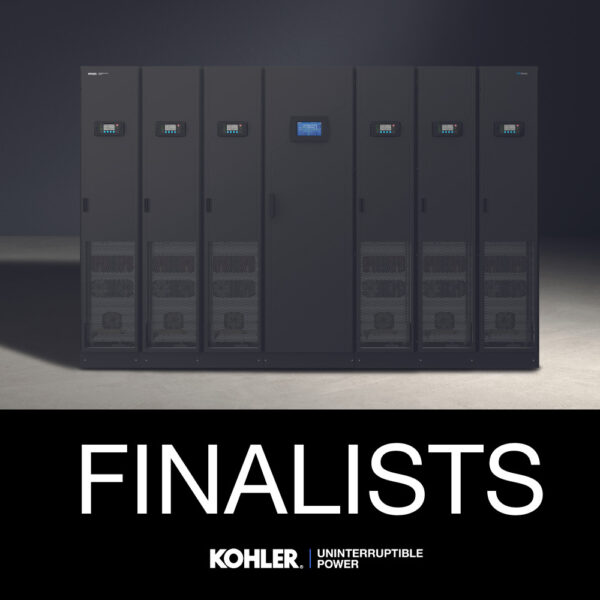Maximising UPS efficiency can contribute significantly to this drive, as healthcare facilities typically have large populations of UPS power supplies of varying sizes distributed throughout their sites.
Green energy for healthcare
In this article, Alex Emms, Technical Director at Kohler Uninterruptible Power (KUP), discusses how modern UPS technology offers four key opportunities for improving energy efficiency. These start with using the latest available high-efficiency transformerless UPS systems and employing modular topology for ‘right-sizing’ and efficient UPS loading.
Additionally, efficient operation can be maintained at all times by matching UPS capacity to varying loads, using smart module switching techniques such as Xtra VFI. Finally, uninterruptible power supplies can be operated in eco-mode (Similar to single-conversion mode as defined by HTM 06-01[ii]) if circumstances allow.
Climate change and its challenges
The IPCC is an intergovernmental body of the United Nations. Its report highlights three major issues; that warming in the climate system is unequivocal, that the effect of humans on the climate is clear, and that climate change mitigation requires significant reduction of greenhouse gas emissions.
This is addressed by the UK Government’s Health Technical Memorandum HTM 07-02[i]. HTMs give comprehensive advice and guidance on the design, installation and operation of specialised building and engineering technology used to deliver healthcare. Of these, HTM 07-02 focuses specifically on making energy work in healthcare. It comments that the IPCC warning poses multiple challenges for healthcare facilities:
- to reduce their carbon emissions and contribute to the national and NHS targets for climate mitigation, identify opportunities for adapting to expected climate change and build resilience to extreme climate events
- to support resilient communities including planning services for expected changes in health needs and providing high quality healthcare particularly focusing on needs during adverse climatic conditions.
Green energy generation
As mentioned, one way to reduce carbon emissions is by generating renewable energy on site; NHS trusts are ideally placed to benefit from this. Most are significant property owners; they have 24-hour year-round demands for electricity and heat, and expect to be in business for many decades. These factors make an excellent match for green energy. The most suitable resources for use within NHS trusts are:
- solar energy – solar electric (PV) and solar water heating
- wind energy – harnessed using wind turbines
- biomass (wood) – burning for heat or gasification for CHP
- hydro power – run-of-river hydropower (depending on seasonal river flows)
For solar, wind and hydro power sources which have no fuel costs, and very low operating costs, the reduced energy costs provide a straight cash benefit once the initial investment has been recovered. NHS organisations can also sell renewable electricity to an electricity distributor at a premium, if the distributor and local network can receive the electricity generated. Similarly, they can employ energy storage systems to hold locally generated energy, for example from solar systems. This can be time shifted for discharging at night or to supplement mains power at periods in the day when the mains grid is most stretched and energy costs are highest.
Improving energy efficiency
Energy efficiency strategies can be implemented instead of, or, preferably, alongside energy storage and Green energy generation. Such strategies should include healthcare UPS power supplies, as there can be large numbers of these on-site and all the power for the equipment they protect passes through them. UPS capacity can range from 250W up to several hundred kW. The small units may be single-phase types used to support a single circuit, while the larger UPS systems may be single- or three-phase, supporting a complete department.
Energy efficiency strategies include:
- Using fundamentally energy-efficient technology
- Modular UPS topology
- Smart module switching for UPS energy efficiency under all load conditions
- Eco-mode, if appropriate to on-site conditions
The transformer-based, double-conversion, on-line UPS system, utilising an internal step-up transformer, was first introduced during the seventies. However, advances in power semiconductor technology and improved PWM based waveform generation techniques have facilitated an industry move to transformerless implementations.
This significantly improves energy efficiency, as shown in Fig.1. Transformerless units also have an input power factor much closer to unity and are much less load-dependent than transformer-based uninterruptible power supplies. Electricity costs, and in most instances also cabling and switchgear sizing, will be significantly reduced.
Fig.1:Transformer-based and transformerless UPS energy efficiency curves
Transformerless technology also yields some secondary, but equally important benefits. As eliminating the transformer considerably reduces size and weight, UPS can be implemented as small, rack-mountable modules rather than as large, floor-standing systems.
This means that future-proofing, and scaling to efficiently match the critical load size, can be managed efficiently. For example, consider KOHLER Uninterruptible Power’s KOHLER PW 9250DPA UPS; this contains a frame which can accommodate from one to six 50 kW modules.
On initial UPS installation, the UPS frame could be populated with three modules supporting a 150 kW load. Extra modules can easily be plugged in if the load grows, or to provide redundancy. In this way, the KOHLER PW 9250DPA can be vertically scaled with up to six modules to support a 300 kW load or 250 kW load with N+1 redundancy. Up to six such racks can be connected in parallel for horizontal scaling and a capacity of up to 1.5MW. Different modular UPS power ranges allow for smaller or larger systems.
Note that this scalability allows the UPS capacity to always be matched closely to the changing load capacity, while redundancy can be added for just 50 kW overhead. By comparison, a monolithic system would need to comprise two separate units, with a doubling in capacity, to provide either future-proofing or N+1 redundancy. Apart from the extra power, and additional cooling, that would be demanded by this unwanted surplus capacity, the uninterruptible power supply could never be more than 50 per cent loaded.
Smart module switching
Although modularity and scaling will manage long-term changes in the critical load, even modular UPS power systems can be exposed to under-loading due to short-term fluctuations in demand. Physically adding or removing modules to accommodate these rapid changes wouldn’t be practical – but the modules can be switched in and out of service.
This technique is known as smart module switching, as implemented by the Xtra VFI feature found in the KOHLER PW 9250DPA and other KUP UPSs. This intelligent feature minimises loss and improves efficiency when UPSs run in double conversion mode. When enabled, it automatically adjusts the number of active modules to match load requirements. Surplus modules are switched to standby but remain ready to transfer to active mode in a fraction of a second if the load increases.
The efficiency improvements achieved by this mode of operation are especially significant when the load drops below 25 per cent of full UPS system capacity. Fig. 2 below shows how the Xtra VFI operating mode can enhance efficiency for a KOHLER PW 9500DPA running at a low load level. The illustration applies to a system with 10 modules of 100 kW rating, supplying a total available capacity of 1MW.
When the system calculates the optimal module count for maximum efficiency, it allows for the desired redundancy level; UPS availability is not compromised. Also, the redundancy level for active capacity and the highest expected load step can be user-configured to guarantee the highest possible protection level. If a mains failure or alarm occurs, the Xtra VFI mode is automatically deactivated; all modules are immediately switched to active status.

Fig.1: How Xtra VFI improves UPS energy efficiency at low loads
UPS co-mode
Efficiencies of 99 per cent or more can be reached by operating a UPS in eco-mode. However, this mode is only suitable for certain situations; either where the critical load is insensitive to momentary power failures or anomalies, or where there is complete confidence in the site power supply’s quality.
In eco-mode, UPSs feed power directly from the utility mains to the critical load during normal operation. The rectifier and inverter, with their inefficiencies, are bypassed. If a mains problem is detected, the load is switched onto the UPS inverter output. This means that the load is exposed to raw mains and any incoming problems such as brownouts or spikes during normal operation.
Additionally, the mode relies on the load’s IT equipment power supplies having sufficient capacitance to ‘ride through’ the switch between mains and inverter, and vice versa. This is to prevent the UPS supplying a transient inrush current to restore lost energy after an outage. Otherwise, line impedance between the UPS and power supplies may cause this current to create a significant power supply input voltage drop.
Accordingly, users should balance the benefits of increased operating efficiency against the extra requirements and risk associated with operating in eco-mode.
Conclusion
The pressure to reduce energy consumption now has three components. Firstly, users must mitigate the impact of rising energy costs on their operating costs. Secondly, they must demonstrate green strategies that satisfy patients and employees as well as government legislation. Finally, climate change has now become a reality that must be countered, rather than a discussion topic.
This article has shown how improving UPS energy efficiency can contribute to energy savings. However, to find the optimum solution for a specific healthcare estate, it’s essential to consult with knowledgeable, well-resourced suppliers like KOHLER Uninterruptible Power.
To find out more about UPS efficiency and talk about our range of UPS services, phone 0800 731 3269 or contact us here.
References
[1] https://www.ipcc.ch/site/assets/uploads/2018/09/AC6_brochure_en.pdf
** Published in the March edition of Hefma Pulse **






